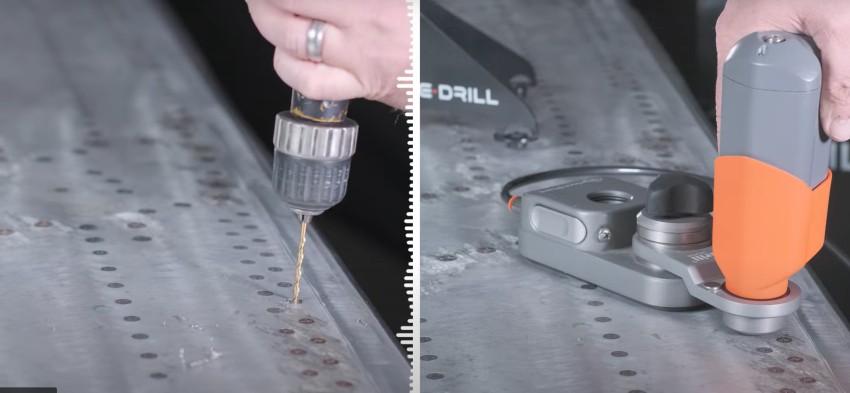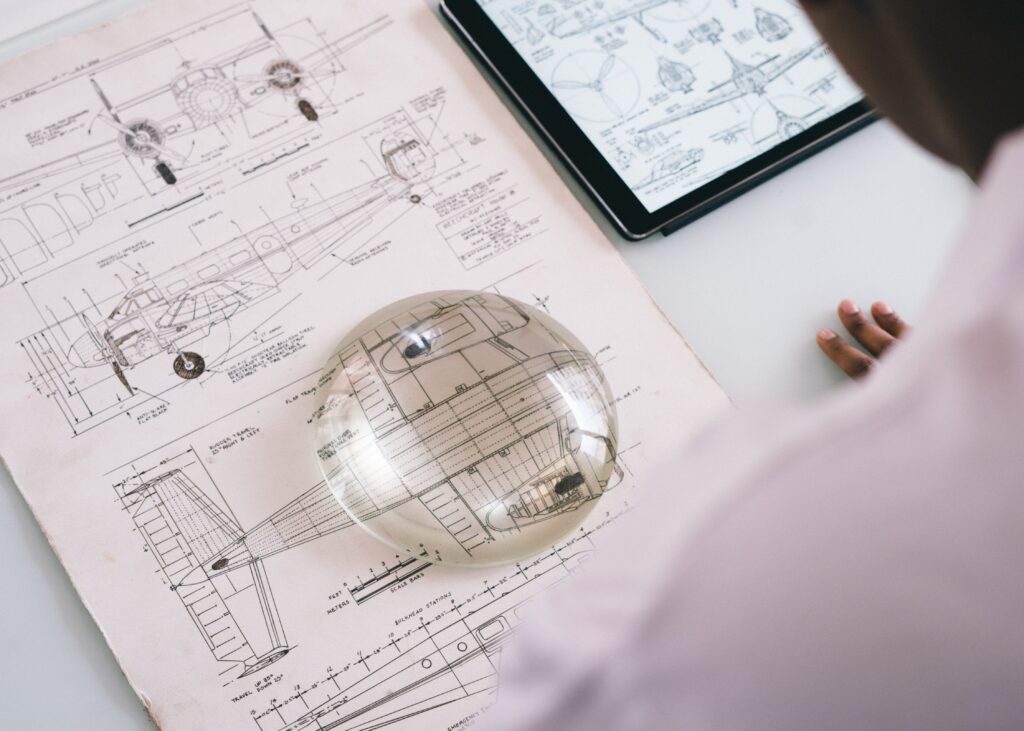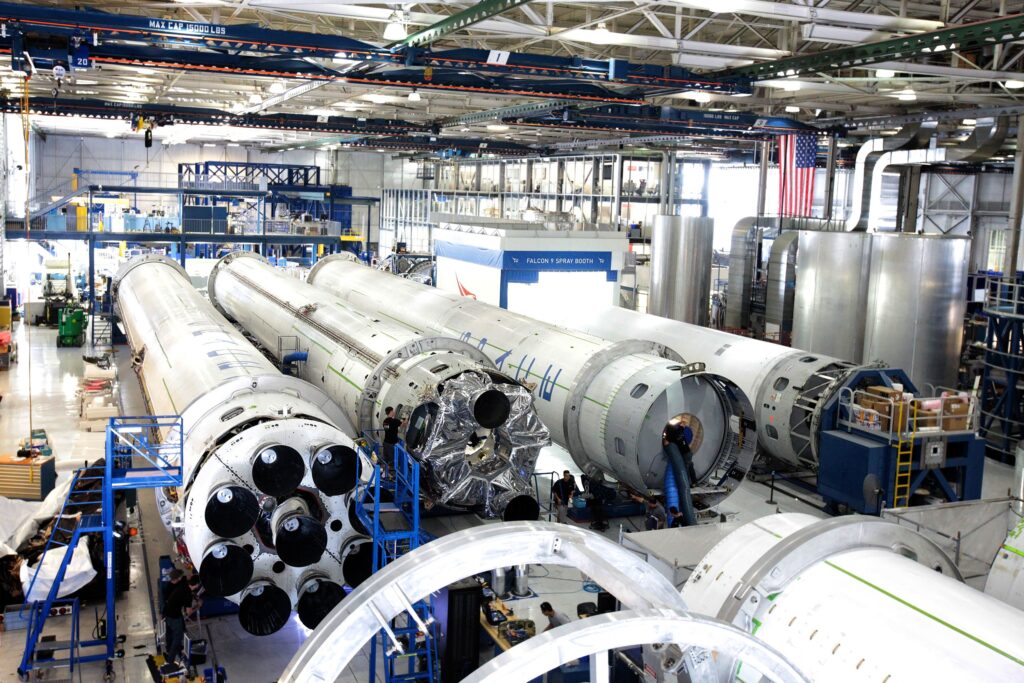E-Drill 2.0 System vs. Hand Drilling in the Aerospace Industry

- August 17th, 2023
- Categories: Uncategorised
In the aerospace industry, a high standard needs to be met when it comes to manufacturing spacecraft. There is a constant search for a production system that will benefit in terms of cost-effectiveness, energy efficiency, and environmental impacts.
Hand drills and electric drills are classic examples of aerospace drilling as they need to meet strict quality requirements such as precision, accuracy, speed, drilling, tightening, and material removal.
Aircraft need to be durable enough to withstand harsh environments, requiring thousands of holes and rivets through materials like titanium. However, what is the difference between the E-Drill 2.0 System and hand drilling, and how are both useful for industries such as aerospace or international defence?
Definition of Drilling
With drilling operations, aerospace drills are not only lightweight but are high resistance and can drill through composite materials and metals such as stainless steel and titanium. These drills are powerful enough with cutting speed to drill into the mechanical properties of aircraft and also hold a longer tool life.
Hand drills and electric drills can maintain surface integrity, remove carbon fiber dust or chipping, and limit the number of burrs. The 4 types of drills include pistol grip drills, straight drills, screw-feed drills, and angle drills. Likewise, if you’re looking for tooling and consumables, options include drilling equipment, deburring tools, and Eddie bolt tools.
What to Consider When Drilling?

Feed force, cutting speed, and speed
When hand drilling, it is important to consider reducing the feed force and feed rates by choosing the correct drilling technique, both evaluating the cutting speed and free-cutting speed of the drill.
The drill bit
Drill bits are commonly made with high-speed steel, and the material, surface treatment, and drill bit type need to be taken into consideration.
The drilling tool
Whether it is cutting speed, feed rates, spindle speed, standard drill bits, or drilling parameters, the drilling process always needs to maintain precision.
What is the E-Drill 2.0 System?
The E-Drill 2.0 System contains 4 components. Compared to the traditional hand drill, the E-Drill 2.0 System is an aerospace fastener removal system that is a go-to for maintenance professionals. When it comes to the drilling of carbon fiber, this system reflects the advancements in drilling technology. So, what does this system consist of?
- The E-Drill hand tool Using an electro-discharge machine (EDM), the system can remove hard fasteners with a seamless cutting speed in seconds. The E-Drill is the only hand-held device that uses EDM technology and can convert between Center Ground and External Ground modes,
- The Mobile Service Unit This uses an interface where the user can select and build various aerospace fastener types, such as removing such fasteners. This makes it beginner-friendly and functional for an experienced user.
- The Rolling Tool Cart This cart an store all consumables and accessories that can remove fastener types.
- The S-Blaster Spot Coating Removal This can effectively remove coatings, fillers, sealants, and corrosion from fasteners that use plastic blast media.
Benefits of Hand Drilling
Although an advanced system like the E-Drill 2.0 is excellent for industry applications, hand drilling still has its purposes.
- A hand drill is portable, lightweight, compact, and easy to drill holes with, especially in hard-to-reach areas. It is commonly known as a manual handling tool.
- Hand drilling has many practical uses such as trimming, feathering, and light to heavy sanding.
- Hand drills assist with drilling countersink holes and installing fresh aerospace fasteners.
- Air drills can help with cutting and trimming windshields or canopies.
- Manual drills speed up the installation or removal process for bolts and nuts.
- Hand drilling can cut large holes in metal, plywood, and fibreglass, making it very versatile for the user.
- A cordless drill can be used anywhere, whether on a plane or without an electricity source.
Benefits of E-Drill 2.0 System
Manual aerospace drills are useful in terms of portability, however, if you want the process of drilling to go faster and safer, an E-Drill 2.0 is advanced enough to do so.
- The E-Drill 2.0 System is an aircraft repair tool with a standard use of 110 volts of power, no longer needing a 220-volt outlet.
- The drill includes a CG and EG all within a single-hand tool, making it a system that is more cost-effective and versatile for the user.
- The E-Drill system includes faster and more efficient cuts for deep-hole drilling.
- Includes a lighter and smaller chasis with a new operating system, making it easier to transport.
- This drill is easier to maintain components and has a redesigned water system. The system is simple to repair and maintain in terms of filter changes and tank cleaning.
Types of Drilling & Riveting Tools

When it comes to drills and riveting tools, they can be used in a range of markets.
Hand tools
Hand tools are essential for aerospace repair, and maintenance, and can boost cutting speed. These can include screwdrivers and bits, helicoil tooling, hole saws and spotters, sealant guns, and lighting hole punches.
Countersinking
Put simply, countersinking is when an engineer cuts a conical hole in a metal object, its spindle speed widening it to make room for a screw head or bolt. Countersink cages, countersink tooling, and countersink cutters are common tools for aerospace repair or maintenance.
Drilling equipment
Aerospace drilling equipment is essential as engineers are needed to drill quality holes in tough materials. The most common type of drilling is axial drilling or conventional drilling and can include drill collets, drill stops, drill bushes, JIFFY tooling, angle drills, and more.
Rivet tooling
Aerospace structures are joined and secured together using a metal rivet. Rivet tools include cherry tooling, huck tooling, rivet shavers, rivnut tooling, rivet removal tools, rivet snaps, and rivet squeezers.
Hi lok tooling
Installed onto airframes, hi lok tools are very lightweight, high strength, have high fatigue resistance in terms of vibrations, and are resistant to corrosion. In terms of aerospace fasteners, you can explore the AN, MS, and NAS Hardware, Specialty Fasteners, Cable Tie Mounts, and Motorsport Fasteners.
Nutplate tooling
Nutplate tools assist engineers in locating and drilling rivet holes, making the nut design easier to align or replace if necessary.
Types of Electric Hand Drills
Electric handheld drill
As a battery drill, this electric handheld drill is perfect for keeping the drilling speed constant with its programmable trigger, keeping the quality of holes. As a smart manual drill, it can be used throughout the fuselage assembly.
Advanced drilling unit
Also known as a Positive Feed Drill (PFD), this unit is essential for high-speed or heavy-duty applications such as supporting the final assembly process.
Handheld angle drill
Shorter in length, this heavy-duty angle aircraft repair tool is helpful in tighter spaces for drilled holes.
Pneumatic handheld drill
With a rubber pistol grip that reduces vibrations and temperature fluctuations, an engineer can use this hand drill for final assembly, fuselage, and consistent hole quality.
Modular drill
With a slim and light design for more narrow areas, the modular electric hand drill includes several heads for hard-to-reach spaces.
Battery pistol grip screwdriver
This screwdriver is not the same as one would use at home. Powered by a Lithium-ion battery, the pistol grip prevents slippage, has front lights for visibility, and is ergonomically designed.
Battery handheld nutrunner tensor SB
With torque monitoring, this handheld includes a high power-to-weight ratio, error-proof tightening, and consumes less energy.
What is an Air Drill?
Air drills are mainly used exclusively to manufacture aircraft, with no danger of fire or electric shock as they are powered by an air compressor. Smaller and lighter than electric drills, air drills are less tiring to use, have high speeds, and are suited to grinding, cutting, and routing operations.
Comparing the E-Drill 2.0 System and Hand Drilling
In comparison to normal bolt removal, the E-Drill 2.0 will cut faster as it is computer controlled and can also sever the fastener head from the stem, quickening the removal process. When compared to a hand drill, the process can take almost three times as long.
Overall, you can reduce damage, labour time, and material costs, eliminating FOD, and reducing the risk of workplace injury. If you choose to use a manual drill for removing or inserting fasteners, you want to take time constraints into consideration. Whichever tool you choose, ensure it is suitable and safe for the job at hand.
Certified Aircraft Repair Tools With Aerospace Tooling and Fasteners
At Applied Fasteners and Tooling, aerospace engineers can search for tools and fasteners to further any aircraft project.
Whether you’re searching for Drill Bits, Cherry Tooling, Countersink Tooling, Hi-Lok Fasteners, Click Bond Fasteners, or Nutplate Spacematic Drill Motors, our quality-certified team has a range of services and technical support to suit your needs. Contact us now for a personalised quote or for more details on how our space fasteners can help.






